The Ministry of Defence has launched a market engagement exercise seeking potential solutions for a new airborne early warning system to protect the Royal Navy’s aircraft carriers and their accompanying strike groups.
Published on April 9th via Find a Tender, the notice — titled Carrier Strike Airborne Early Warning Initial Market Engagement — is “not a Request for Quotation (RFQ), Request for Proposal (RFP) or an Invitation for Bid (IFB)”, but instead “a market research tool being used to determine the availability and adequacy of potential sources for planning purposes only.”
The proposed system would operate from the Royal Navy’s Queen Elizabeth-class aircraft carriers and provide “persistent 24-hour surveillance” in support of Carrier Strike Group operations. This includes the carriers themselves, escort destroyers and frigates, and auxiliary support vessels.
According to the notice, “the primary purpose of the system will be to provide the Carrier Strike Group… with sufficient warning of difficult air and surface threats inclusive of modern anti-ship guided weapons and strike aircraft to allow for effective counter threat action.”
The MOD is exploring options to sustain and enhance its current airborne early warning capabilities beyond the currently fielded Crowsnest system. The notice highlights that this initiative is tied to the outcomes of the ongoing Strategic Defence Review and is “not informing the market of an imminent procurement.”
The MOD estimates the potential value of the future programme at between £500 million and £1.5 billion, with the current working figure noted as £1 billion excluding VAT. Contract delivery is estimated to begin as early as January 2027, with service introduction sometime between 2030 and 2035, subject to review outcomes.
While the Royal Navy’s current airborne surveillance system uses Merlin helicopters fitted with the Crowsnest radar, the notice hints at broader interest in potential future solutions — including alternatives to traditional manned aircraft.
The MOD states: “The implementation options in the RFI are not prescribed, so we are interested in views from all interested parties on the best possible solution.” This could open the door to solutions including fixed-wing aircraft, drone-based systems, or unmanned rotary platforms equipped with advanced sensors.
The market engagement aims to test the assumption that “there are very limited, if not a single, supplier solution(s) to meet the requirement in terms of performance and time.”
Next Steps
Responses to the RFI are due by 17:00 on 6 May 2025, with the MoD encouraging industry input via a Microsoft Form. “Where relevant and appropriate, this market engagement event may be followed by further engagement exercises,” the notice adds.
The MoD makes clear this is not yet a procurement, stating:
“All costs pertaining to the completion of this response are to be borne by the responders,” and that “procurement dates and values… should not be viewed as a firm commitment.”
Still, the level of detail in this notice — combined with the scale of estimated funding — makes clear the Royal Navy is preparing to take a major step forward in its airborne early warning capabilities. A drone-based solution with state-of-the-art sensors appears not just likely, but necessary, to meet the demanding endurance, survivability, and flexibility requirements.


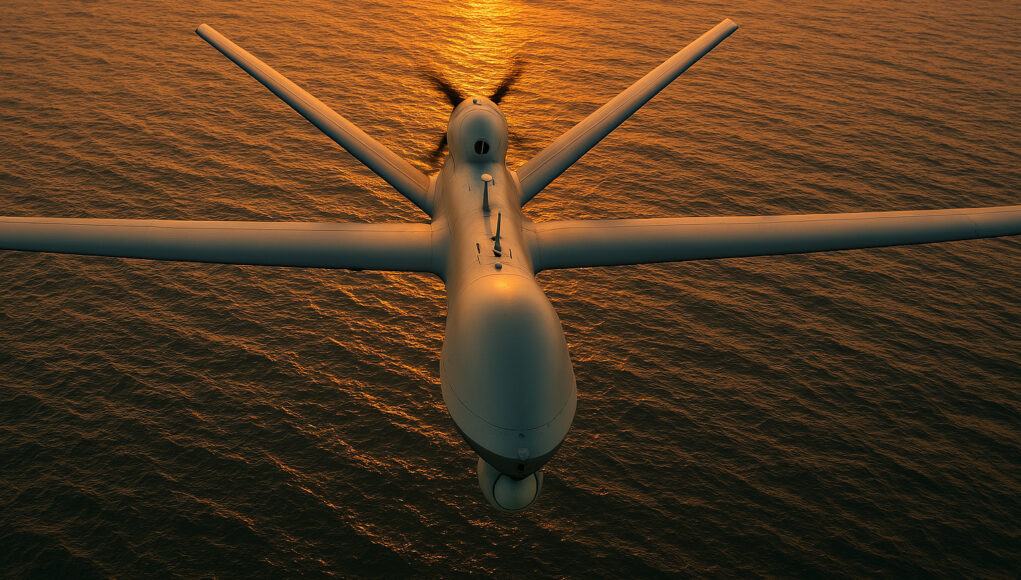

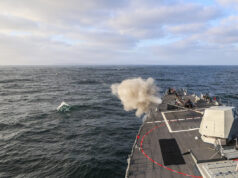
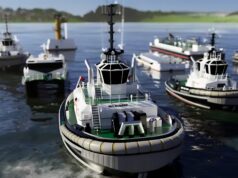
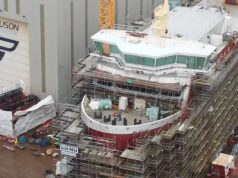
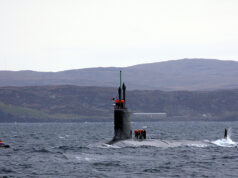
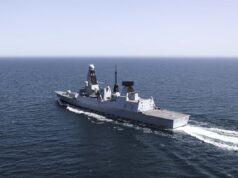

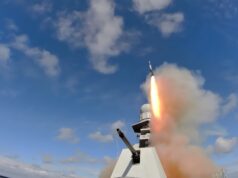
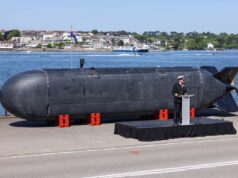
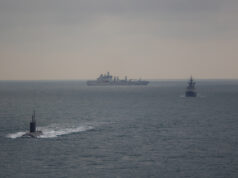

I don’t quite know what I expected the principle method of communication between industry and government to be, but it definitely wasn’t Microsoft Forms.
Please bring back the ‘edit’ function as well.
Drone-based seems to be the way to go – perhaps a configuration of Proteus, if they want a cheaper option. Alternatively, they could splurge on a small EMALS parallel to the ramp for larger, fixed-wing drones. I’m not sure if that’s a priority though – I’d rather see the money go to other projects.
Stol MQ9-b Sea Guardian would not need emals
Yes seems like the only industry solution available however sea spray radar on MQ9 is no substitute for the search water radar on crowsnest.
Hi Jim have you had a look at an article on The War Zone re the Boeing MQ-25 and its inherent range / additional capabilities ?
Yes you would need some form of Cats / Traps, it’s expensive but it ticks a lot of boxes all in one package.
It’s stealthy, has multiple uses such as A2A refuelling, MP or even AEW and it’s built for carrier ops.
Have a read it’s interesting.
I just don’t see the MQ-9 or A Mojave variant being very robust on a carrier.
Especially when systems such as HHQ-9B can reach out beyond 300km to strike vulnerable drones with only short-range AEW capability.
@ABCRodney
The problem with MQ-25 is even the present bog standard air to air refuelling model is coming in at more than a 5th generation fighter.. add in a good sensor set and the cost will be eye watering..
JOIN US Everybody can earn 250$/h + daily 1K !!! Start now making every month extra $6000-$22000 or more by just doing an easy online work from home. Last month i have earned and received $19650 from this work by giving this only 3 hrs a a day.Every person can now get this work and start earning online by..
For details check ——-⫸ 𝗪𝘄𝘄.𝗛𝗶𝗴𝗵𝗣𝗿𝗼𝗳𝗶𝘁𝟭.𝗖𝗼𝗺
Hi ABC, yes thanks I did see the article on the MQ25 operating in a AEW role however I didn’t read it as something that had actually been proposed yet and was more of a concept. I did not see any mention of what the AEW sensor would be although I’m sure they must have worked up some options already.
It would be an amazing capability for us and I believe MQ25 was very much the aircraft they had in mind when setting out Project Ark Royal.
I agree on MQ9 having difficulties on a carrier operations certainly in the North Atlantic.
Everybody can earn 220$/h + daily 1K… You can earn from 6000-12000 a month or even more if you work as a part time Work…It’s easy, just follow instructions on this page, read it carefully from start to finish… It’s a flexible job but a good eaning opportunity..go to this site home tab for more detail thank you…….
COPY AND OPEN →→→ 𝗪𝗢𝗥𝗞𝟰𝟰.𝗖𝗢𝗠
I doubt they’ll find anything they like in those timescales. Might be better off getting the sort of Merlin conversion that should have been done ten years ago, with a powerful X-Band radar on either side, ECRS Mk 2 perhaps? We’ll need new Merlins though (especially if we are building them for Norway). As drones? Not initially, but maybe that could be worked on over time. Conversions are becoming a more standard thing. No reason not to have the comms links available to use remote analysis though, so at least the command aspect can be shifted out of the cab.
Signal is reserved for hot ops, so Microsoft Forms is the logical solution.
JOIN US Everybody can earn 250/h Dollar + daily 1K… You can earn from 6000-12000 Dollar a month or even more if you work as a part time job…It’s easy, just follow instructions on this page, read it carefully from start to finish… It’s a flexible job but a good eaning opportunity.tab for more detail thank you……..
COPY AND OPEN →→→→ 𝐖𝐖𝐖.𝐖𝐎𝐑𝐊𝐒𝐓𝐀𝐑𝟏.𝐂𝐎𝐌
Introduction between 2030 and 2035. With the existing system due to retire at the end of 2029. So a potentially highly hazardous capability gap for the navy’s crown jewels it is then! These inept clowns never learn.
I’m not super worried about this particular gap, as I believe Crows Nest will almost certainly be extended.
Yes, I would think that as well
I think the problem is actually crows nest.. if it worked they most definitely would have extended.. it’s a bit damming that they are getting rid of it a few years after its just become operational.
The subtext is they never have got it work as it should and the RN want shot if it.. so they can get something that does work well and gives them all those ASW cabs back ( because it’s essentially taking almost 40% of its ASW cabs to support this role ).
Is it that Crowsnest itself doesn’t work, or that it takes a Merlin (one of only a fairly small number) out from other tasks, and has a shorter endurance and lower service ceiling?
It’s just not that good for new threats with lower RCS.
Everybody can earn 220$/h + daily 1K… You can earn from 6000-12000 a month or even more if you work as a part time Work…It’s easy, just follow instructions on this page, read it carefully from start to finish… It’s a flexible job but a good eaning opportunity..go to this site home tab for more detail thank you…….
COPY AND OPEN →→→ 𝗪𝗢𝗥𝗞𝟰𝟰.𝗖𝗢𝗠
I am wondering if the rotors may interfere with the effectiveness of the signals. Especially with incoming Ballistic Missiles. Its got to be 100% a fixed wing solution for almost all the aeronautic reasons you can think of.
Unfortunately UK stupidly decided to forget fixed wing two decades ago. We now only have Brittan Norman in the business. We need to rethink where we are going with our general lack of air mindedness.
Or we just don’t deploy the carriers very far from home and have other assets flying from land bases providing AEW..This year will be the last time the carriers will deploy globally for the foreseeable future.
i expect crowsnest will be extended if necessary
I wonder whether Hybrid Air Vehicles will offer a solution.
I have no idea if its practical or not, but I do rather like the idea of an airship based solution. Big enough to power the system and to have crew on board that can rota on and off for persistent surveillance. It could almost be considered a crewed vessel in its own right, with its own form of RAS (no idea how) keeping it topped up with fuel, water and sausages as needed.
They can even land on water (or perhaps on the stern of the carriers with a little planning) for maintenance etc.
They do seem to be pushing maritime patrol as one of the main military roles for Airlander, and it would be a neat solution to the issues at hand.
But realistically this requirement, with the extra push for ‘surveillance’ of surface threats, is made for Protector STOL.
Those are the two main options and both really cool systems, but Protector is the one to beat here.
It’s also where the Airlander idea started – with a US project that was ultimately cancelled.
I can’t see Airlander being even remotely practical for this work other than from land. It’s never going to fit on a Carrier, It’s never going to be suitable in Bad weather conditions and it’s not the answer here.
Doesn’t have to fit on the carrier, I once emailed HAV (and listened to some of their podcasts) and apparently they are working on a sort of ‘vertical RAS’ system so that the airship can resupply from a warship by flying above it. As an alternative they can land on water and do a RAS that way.
The airframe can handle anything an airliner could, so no worries with regards to its robustness. The main concern is whether driving against the wind to maintain position will kill endurance, which I doubt given the huge internal volume and disposable payload available. The main limit will be the welfare of the crew, I would imagine, that cabin doesn’t look very spacious for multiple day missions.
A couple of final notes:
Airlander can carry a complete F-35 power egg.
As with large aeroplanes, Airlander can be fitted with different cabin lengths. Internal space is not a problem. It is also low noise and low vibration. Much kinder to people and machines than any aeroplane or helicopter.
Declaration of interest, I work for Hybrid Air Vehicles.
Buoyant aircraft have been proven to be able to touch down on carriers for replenishment and crew change. In the 1940s and 1950s, the United States Navy did it with much smaller and less capable aircraft than Airlander. In the linked thread there is a picture labelled “A ZSG-3 blimp lands on the flight deck of the escort carrier Sicily CVE 118.”. In that picture, the relative sizes of the aircraft and the carrier are about the same as Airlander against a current UK Queen Elizabeth class carrier.
https://axis-and-allies-paintworks.com/e107_plugins/forum/forum_viewtopic.php?16725
Declaration of interest, I work for Hybrid Air Vehicles.
Thanks for the info, very interesting.
Are Airlander working towards in this contract?
Buoyant aircraft are much more capable in weather than popular misconception believes.
During 1914-19818, very small Royal Navy airships operated all round the UK coast. One main base is now RAF Mona, a part of the UK not noted for calm, dry weather.
From 1942 to 1962, the United States Navy operated medium and large airships all year round over the Pacific, Carribean and especially the North Atlantic. In particular, Operation Whole Gale during one winter in the late 1950s, the ZPG-2 class AEW airships had better on station time than the EC-121 aeroplanes trying to do the same job. There is not much about it on the internet or even in proper books but at work I have copies of the contemporary reports from Lincoln Laboratories.
The Capability is proven.
Declaration of interest, I work for Hybrid Air Vehicles.
Airship handling in high wind/storm conditions not good.
Yes, ultimately RN is Atlantic ASW focussed.
Question is, does Airlander’s endurance (5 days manned, 20 days unmanned) allow it to ride out storms and simply fly around them, or does the low speed make it vulnerable to being stuck downwind and using up endurance to keep station?
I doubt Protector STOL with that low a wing loading will do well in a storm either
I think you answered it pretty well. It’s just not practical. Any system will have to be a step up from Merlin in capability and performance.
Start now making every month extra $8000-$22000 or more by just doing an easy online work from home. Last month i have earned and received $19650 from this work by giving this only 3 hrs a a day.Every person can now get this work and start earning online by.
For details check ——-⫸ WWW.WORKSPROFIT7.COM
A lot better than popular misconception believes. Look at what United States Navy did from 1942 to 1962 with the ZPG-2 class aircraft.
Declaration of interest, I work for Hybrid Air Vehicles.
I think we will be going for a mohave type solution? No need for cats and traps. I think they’ll need to increase power generation though
A Mojave derivative could operate STOVL without the need for Cats but could it handle the weight of a AEW radar?
And energy requirement?
Yeah, that’ll get it done (eyes roll)
Let’s see if they finally ask for something and at least another 2 AEWs for the RAF. Nothing but blah blah but the armed forces are unarmed.
Fairy Rotodyne is the way to go…
Yeh, a gyroplane so the main rotor was not powered meaning no need for a tail rotor – very clever.
Back in the day when the UK had some very clever world beating ideas…
Cheers CR
I think the original Fairey Rotodyne but with modern engines, avionics and composite structures would be a better performing and cheaper (but slower) aircraft than the Bell Boeing V-22 Osprey. If BAE Systems wasn’t just a profit obsessed shell of an aircraft manufacturer then they could still develop a modern version of the Rotodyne including an AEW version.
The c.£1Bn indicative budget seems low. Seems yet another attempt to do carrier based AEW on the cheap. As far as I’m aware, Crowsnest still has not reached FOC and is its due to retire by 31 Dec 2029, effectively £500M and a lot of time and effort wasted. Meanwhile our carriers will lack organic AEW platforms for the best part of two decades (2018-2035), and it’s not as though the RAF can fill the gap as they used to claim they could!
I often wondered if a ‘kite’ equivalent could work. In WW2 German Uboats towed an gyrocopter for over the horizon observation. A modern equivalent with an electrically powered rotor lifting a radar system and tethered to the towing ship might be a simple solution. Maximum altitude would be limited by the weight of the umbilical cable and the ability of the rotor craft to lift that cable, but it might work and might be comparatively cheap.
You would loose the advantage of having the radar away from the fleet. By having the radar on a platform away from the fleet, the fleet can be Emcom but not blind. In effect you will have a flashing neon sign saying “ FLEET HERE”
exactly. It’s like a giant bullseye on the map
Everybody can earn 220$/h + daily 1K… You can earn from 6000-12000 a month or even more if you work as a part time Work…It’s easy, just follow instructions on this page, read it carefully from start to finish… It’s a flexible job but a good eaning opportunity..go to this site home tab for more detail thank you…….
COPY AND OPEN →→→ 𝗪𝗢𝗥𝗞𝟰𝟰.𝗖𝗢𝗠
De Havilland Otter with a STOL kit?
I think fixed wing is the way to go. A Britten Norman Islander with folding wings. Still in production & made in the UK. You would need to sort the u/c and maybe fit a hook. Might also need to revisit flaps etc to give it a very short t/o and landing. Whether it would clear the Island and ramp is another question! Would a carbon fiber upgrade work?
Has communications and low intensity intruder potential. Much cheaper to run than all this fancy stuff and it would work too.
I would like to see the MoD / RN take the opportunity to ask for a system of AEW systems.
The specification above for Carriers and a smaller system capable of operating from escorts mounting a small radar and or optical / IR sensors. You could have situations in the High North, for example, during the sustainment phase of an operation in which the carrier/s have cleared off to do something else leaving a few escorts and RFA’s supplying the commando force ashore. So if each ship carried a couple if heavy(ish) lift quadcopers each fitted with a small radar you could network them together to create a synthetic aperture radar to provide at least some over the horizon early warning. I vaguely remember some of the sort being being put forward a couple of years ago…
There have been proposals in the past for quadcopters capable of carrying various quick change mission specific payloads for rapid re-roling…
Cheers CR
It may not be a quadcopter, but that’s how Proteus is configured, with exchangable mission inserts for radar, heavy lift, sonobuoy dispenser, etc. It’s the size of a small helicopter though, so you might have issues carrying more than a couple. I’m not sure how well the rectangular radar dispayed (probably a Seaspray like those on the Wildcats) would network. Potentially you could use those already on the Wildcats, assuming they’ve updated the datalink.
I think the problem is actually crows nest.. if it worked they most definitely would have extended.. it’s a bit damming that they are getting rid of it a few years after its just become operational.
The subtext is they never have got it work as it should and the RN want shot if it.. so they can get something that does work well and gives them all those ASW cabs back ( because it’s essentially taking almost 40% of its ASW cabs to support this role ).
I would image it’s going to be drone based as I cannot see it being a manned platform.. but what drone can cart the power supply and size of radar needed.. can it be a vertical take off and landing drone or will they need to carve up the carriers a bit.
They can’t get anything that works well in the timeframe because it doesn’t even exist in concept now. Then there’s the money. Let’s say they are willing to work with 6 purpose-built replacements and we ignore the issue of getting it off a carrier deck. You couldn’t buy 6 good AEW planes for a billion, much less integrate them into the Navy. Then you have to make it carrier compatible. There are some things it’s reasonable to ask for quickly. This isn’t one of them. You’ll need outside the box thinking and a lot of time to deliver a good AEW off a STOV/L carrier.
Something like an Leonard AW609 Tiltrotor VTOL Aircraft fitted with the SAAB Erieye AEW/AEW&C-System?
Not big enough. The AW609 is actually quite small.
The AW609 cannot be used for military applications..a bit of a U.S. stitch-up.
Pretty sure E2s were assessed as being able to launch from the CVFs with some strengthening to the nose gear. Got to say that I think they’d likely provide the best option….
Would require installing wires
Start now making every month extra $8000-$22000 or more by just doing an easy online work from home. Last month i have earned and received $19650 from this work by giving this only 3 hrs a a day.Every person can now get this work and start earning online by.
For details check ——-⫸ WWW.WORKSPROFIT7.COM
If looking for a drone-based solution, would Taranis (adapted with the right radar) not be a potentially viable solution?
It would require a small EMALS, but would likely have the service ceiling and endurance for the job.
Add cats and traps, or better still, bin the lot.
How is that better
With C&T You can have E-2D
Another American system
So that’ll be several £billion and years out of action to reconfigure the carriers for CATOBAR, and then to spend more money on E2Ds, which makes us even more dependent on the increasingly-unreliable US.
As much as some don’t like it, our carriers are set up for STOVL aircraft. We need to work around that, at most fitting a small EMALS for drones, rather than plan on multibillion, years-long projects just to rebuild the carriers.
So leaving ASW operations in the Barents Sea/Artic without air cover, exposed to ruZZian aviation?
Only now and no urgency?! They are not serious. This is vital.
So, autonomous drones, obviously, there’s no point in heaving a human up there anymore.
But also a distributed VLBI system as well.
So, half a dozen drones up, constantly cycling back for fuel and maintenance.
It’ll need to be big, so it’ll need that drone EMALS, but that’s essential anyway, manned fighter only carriers are going to go Dodo on us.
Can start looking at anti-stealth radar with a distributed system too, looking for wide angle scatter off a J-22 Ultimate Dragon or whatever they’re called.
Orbiting autonomous fuel drones will be great too, refuel your F-35s as soon as they’re up.
There should be two flight systems running, manned and autonomous, with the autonomous system just quietly looking after itself, a decision tree ordering sorties for its drones down to the hanger while the manned side just has services to consume from the drone side, fuel, sensors, wingmen, etc.
As a mere observer rather than expert I would suggest a shortlist based on airframes currently in production due to timescale,
1-E2 I would say a strong contender if Carriers reconfigured to cats and traps, but very pricey.
2- Merlin but with AESA radar pods, TWZ have a good article on it (April 2021) and never made clear why they went with an older style system, cash ?
3- GA MQ-9B STOL or similar, Looks a possibility if an appropriate radar and electronics pod can be fitted
4- Bayrakar Akinci. With radar and electronics pod if viable
E2 would be nice but I suspect not in our price range.
A Merlin upgrade would be the most likely as airframes currently in service.
Either drone is a possibility, but Turkey might be more inclined to license uk production.
Something else.
It will be interesting to see what they go with.
It would take even longer and be even more expensive to reconfigure the carriers to CATOBAR for an E2 than to build a drone platform from scratch.
Not an engineer but really think a tilt rotor is a good fit for QE carriers, like the v247 unmanned or maned tilt rotor the USA army going to replace Blackhawk with. Will give range or loitering.
Lots of trouble with tilt rotors, look at V-22
There is another option.. just don’t bother having a carrier based AEW beyond what we have already and actually increase our main AEW capabilities by having more Wedgetails.. in the end wedgetail has a range of 4000 miles, is able to be in flight refuelled has a detection range of 850km.. they can sustain missions of 17-18 hours.
If you then add in the fact the UK has sovereign runways across the Atlantic, in the western and eastern med well as in the mid Indian Ocean.. if the UK purchased an Adequate number of wedgetails it could provide AEW cover for carrier ops across most of the areas it would likely deploy its carrier…apart from the pacific..and I’m not entirely sure we would ever send a carrier to the pacific in a hot war.
Just an off the wall thought.. as if we are focusing our carriers for the euro, Atlantic, high north, western Indian Ocean then more wedgetails may actually be the best most adaptable route.. it may piss the navy off.. but if the carriers are a purple asset, then what does it matter where the AEW is based as long as the carrier gets cover.
That looks like a recipe for failure akin to Italians and “Italy is an aircraft carrier”
All maintenance, airbases management and defence would need also to consider carriers.
I agree, not always practical.
Just posing a question really, as all things ‘Naval’ are not my ‘bag’. Couldn’t a satellite provide the early warning required, both near and far?
3 posts from For details check ——-⫸ WWW.WORKSPROFIT7.COM are spam
Everybody can earn 220$/h + daily 1K… You can earn from 6000-12000 a month or even more if you work as a part time Work…It’s easy, just follow instructions on this page, read it carefully from start to finish… It’s a flexible job but a good eaning opportunity..go to this site home tab for more detail thank you…….
COPY AND OPEN →→→ Www.HighProfit1.Com
AW609 tiltrotor with integrated airborne air and sea search radar with 2 operators plus the 2 pilots. Suggested radars would be the Leonardo Osprey AESA flat panels with 2 antennas fitted nose and tail with 2 back to back updated BAE Sampson radars mounted on top of the aircraft in beam manner like erieye. This would give around round 360 tracking. The Osprey has a cargo lifting capability of around 2,600 kg. The suggested radar weight approx 12kg for each osprey antenna and 350 kg for each Sampson antenna. So I reckon for around 2,000 kg one could install all antennas plus the in-cabin monitoring and communications equipment, toilet and small galley/ storage area, leaving 600 kg for 2 flight crew in the cockpit, and 2 operators in the main cabin.
The decision to go with a STOVL carrier will plague the RN for the next 30+ years.
Well deserved. They had all the facts and they chose to save a pittance at the fleets expense.
Even before the nonsense with the USA – it was still the worse option of the two, with F-35C being a much better fit for the carriers. Now that the USA is proven to be incompetent at best and outright hostile at worst, it’s pushed us into a corner whereby our fleet is utterly dependent on them – with NO alternatives foreign or domestic.
I remember being so disappointed at the time, and I still am to this day.
Even if we had F35C, we weren’t going to go and buy Rafale or something.
I really don’t understand what the fascination is with EMALS and Catapult launching for small drones in general.
People have been Winch Launching 850kg gliders with 300hp diesel engines cheaply and reliably for years. It wouldn’t take very much at all to scale this up to several tonnes capacity. Particularly when a winch would only need so support helping get a drone up to take off speed and not necessarily a climb. The Drone would also be assisted by its own engine…..
I seem to recall the Turkish looking at something similar for their own carriers.
From my understanding of the technology
You are not going to get any kind of capability that is even close to what they want on a small enough package to operate unassisted off a deck..
Eg radar range, power and resolution on something relatively compact and lightweight.
You are either looking at putting cats and traps on the.carriers or have dedicated tilt rotor type aircraft.
The ultimate and most cost effective solution may be to bite the bullet and fit CATs and Trap to operate and existing design. Eg French Thales system the French use.
Before everyone jumps on me regarding the cost of putting CATOBAR on the two carriers, I do not think it will be as costly as people think as the work is half done and as the French are going to be putting EMALs on their new design of carrier. Now might be a good time to get on board and jointly develop it.
Assuming we don’t just buy the general atomics system off the shelf.
French bought the American design Cats
Tiltrotor aircraft like the Bell V-280 Valor or the unmanned Bell V-247 Vigilant offer longer range, higher speed and greater endurance compared to helicopters but are likely to enter service no earlier than the early 2030’s.
AESA radars could be mounted fairly easily to both sides of the aircraft but with swivel mounts similar to the Leonardo/Saab Raven ES-05 radar as used in the JAS-39 Gripen E which has a 200 degree scan angle then full 360 degree coverage could be attained.
By starting such a development program soon then an AEW version of the Valor and/or Vigilant could be attainable with the introduction of that aircraft type.